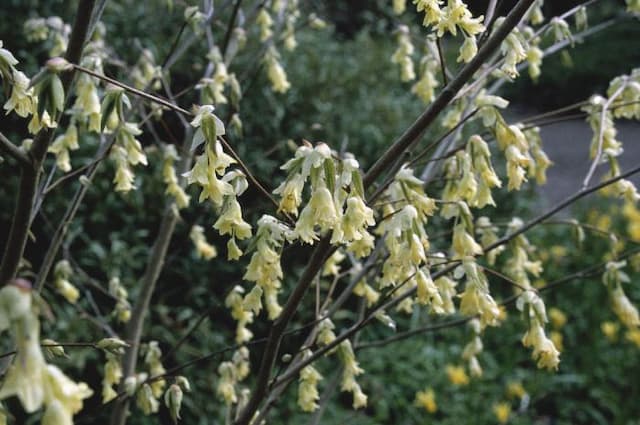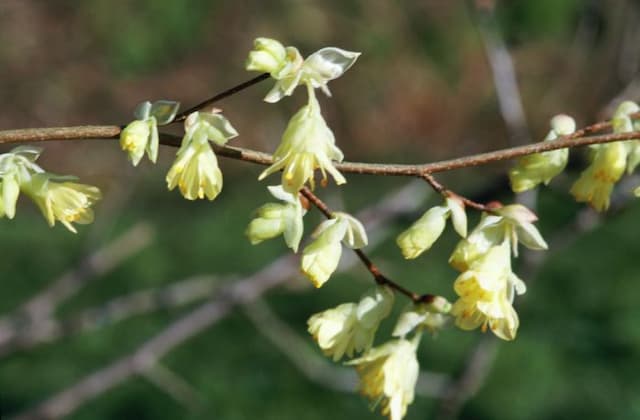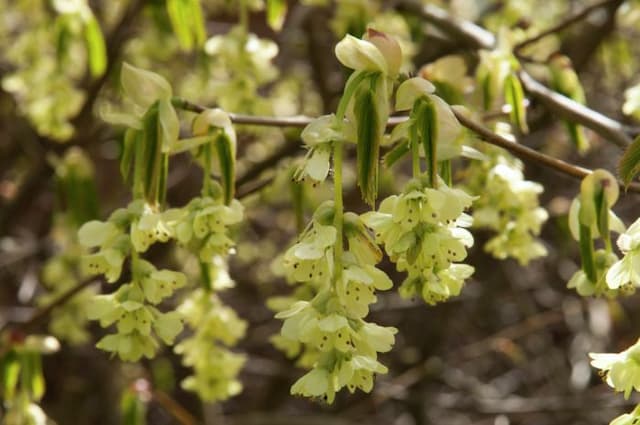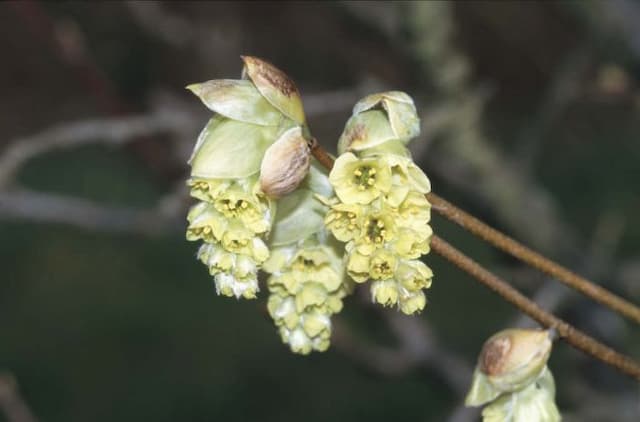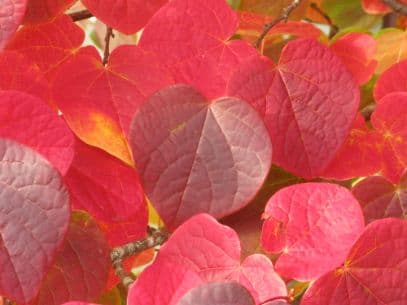Chinese Winter Hazel Corylopsis sinensis var. sinensis 'Spring Purple'

ABOUT
The plant known as 'Spring Purple' bears a graceful presence with a noteworthy display of seasonal color changes. During the early spring, it unveils its charm with a plethora of small, bell-shaped flowers, which exhibit a pale yellow hue often accented with a hint of red at the base, creating a delicate and inviting spectacle. These flowers hang elegantly in pendulous racemes, adding a whimsical touch to the plant's overall appearance. As the season progresses, the foliage begins to emerge, initially showing off an eye-catching purplish or bronze color that gradually matures into a lush green. The leaves are ovate with a subtly serrated edge, presenting a soft and smooth texture. They are arranged alternately along the stems, contributing to the plant's orderly yet natural aesthetic. Autumn bestows a final transformation upon the foliage, as the leaves turn to vibrant shades of yellow, enriching the garden with a warm glow reminiscent of its springtime radiance. The contrast between the seasonal colors provides a dynamic visual interest throughout the year. 'Spring Purple' possesses a refined and delicate beauty which can be appreciated without necessarily considering its dimensions. The intricate details seen in the flowers and leaves, along with the shifting hues that accompany the changing seasons, encapsulate the plant's captivating character.
About this plant
 Names
NamesFamily
Hamamelidaceae
Synonyms
Chinese Winter Hazel, Spring Purple Witch Hazel
Common names
Corylopsis sinensis var. sinensis 'Spring Purple'.
 Toxicity
ToxicityTo humans
There is limited information available about the Chinese witch hazel 'Spring Purple' as it relates to human toxicity. As a general practice with garden plants, caution should be exercised because not all potential toxicities are well-documented. If any part of the plant is accidentally ingested and symptoms of poisoning occur, it's important to seek medical attention. Symptoms could potentially mirror those of other known plant toxicities, such as gastrointestinal upset, vomiting, or diarrhea, although specific toxic effects of this variety are not well-characterized in the literature. Always err on the side of caution and keep unknown plants away from children who might accidentally ingest plant material.
To pets
Information on the toxicity of Chinese witch hazel 'Spring Purple' to pets is not widely documented. Many plants can pose a risk of toxicity to pets, resulting in a range of symptoms from mild to severe if ingested. Typical signs of plant poisoning in pets can include vomiting, diarrhea, drooling, weakness, or even more severe symptoms like difficulty breathing or changes in heart rate. Without specific information on the toxicity of Chinese witch hazel 'Spring Purple', it is advisable to prevent pets from ingesting this plant. If you suspect your pet has ingested part of the plant and is showing signs of illness, please contact your veterinarian immediately.
 Characteristics
CharacteristicsLife cycle
Perennials
Foliage type
Deciduous
Color of leaves
Green
Flower color
Yellow
Height
6-10 feet (1.8-3.0 meters)
Spread
6-10 feet (1.8-3.0 meters)
Plant type
Shrub
Hardiness zones
7
Native area
China
Benefits
 General Benefits
General Benefits- Aesthetic Appeal: Adds visual interest to garden landscapes with its distinctive purple foliage and yellow flowers.
- Seasonal Interest: Provides a showy display in early spring when many plants have yet to bloom.
- Attracts Wildlife: Bees and other pollinators are attracted to its flowers for nectar.
- Low Maintenance: Requires minimal care once established, making it suitable for various garden settings.
- Drought Tolerance: Once established, it can withstand periods of dry weather.
- Adaptable: Can thrive in a range of soil types, as long as there is good drainage.
- Deciduous Nature: Sheds leaves in autumn, providing seasonal change and reducing the need for pruning.
 Medical Properties
Medical PropertiesThis plant is not used for medical purposes.
 Air-purifying Qualities
Air-purifying QualitiesThis plant is not specifically known for air purifying qualities.
 Other Uses
Other Uses- Art and Craft Supplies: The distinctive leaves of the Chinese witch hazel can be used to create natural stamps for crafts or patterns in printing techniques.
- Natural Dyes: The leaves and petals might be boiled to extract natural dyes for fabrics or papers.
- Photography Props: Branches of the Chinese witch hazel can be used as elegant props or backdrops for outdoor photography, especially when the shrub is in bloom.
- Landscape Design Education: Chinese witch hazel can be utilized as a living example when teaching about plant form, texture, and seasonal interest in landscape design courses.
- Bonsai: With its attractive branching and foliage, the Chinese witch hazel can be trained as a bonsai specimen.
- Seasonal Decorations: The flowers and branches can be integrated into wreaths and arrangements for spring-themed decorations.
- Scented Gardens: Due to its fragrant flowers, the plant can serve as a feature in gardens designed to appeal to the sense of smell.
- Wildlife Shelter: The dense foliage can offer nesting sites and shelter for small birds and beneficial insects.
- Nature-Inspired Artwork: The overall shape and flowers of this plant can be the subject of paintings and other forms of botanical art.
- Educational Tools: The plant's various life stages can be used to teach about phenology, the study of plant and animal life cycle events.
Interesting Facts
 Feng Shui
Feng ShuiThe Chinese Winter Hazel is not used in Feng Shui practice.
 Zodiac Sign Compitability
Zodiac Sign CompitabilityThe Chinese Winter Hazel is not used in astrology practice.
 Plant Symbolism
Plant Symbolism- New Beginnings: Corylopsis sinensis, also known as Chinese winter hazel, blooms in early spring, symbolizing the start of a new cycle and fresh starts.
- Hope: It’s one of the first plants to flower after winter, offering a sign of hope and the return of warmth and sunlight.
- Rejuvenation: With its ‘Spring Purple’ variety, the plant represents rejuvenation of nature and the spirit as the purple tints and fragrance fill the air.
- Renewal: As a herald of spring, Chinese winter hazel suggests the theme of renewal, both in the natural world and personal lives.
- Innocence: The delicate flowers can signify innocence and purity, common themes in early spring blooms.
 Water
WaterThe Chinese Witch Hazel 'Spring Purple' needs to be watered regularly to keep the soil consistently moist, especially during spring and summer when the plant is actively growing. The plant should be watered thoroughly, allowing water to penetrate deeply into the soil, which usually means providing about 1 to 2 gallons of water weekly, depending on weather conditions and soil type. Be sure to reduce watering in the fall and winter months when the plant's growth slows down, adjusting to provide about 1 gallon every two weeks or so. It is important to avoid overwatering and ensure good drainage to prevent root rot, which can be detrimental to the plant's health.
 Light
LightThe Chinese Witch Hazel 'Spring Purple' thrives best in a location with partial shade to full sun. An ideal spot would be where it can receive some direct sunlight, especially in the morning, but is protected from the intense heat of the afternoon sun. A site with bright, indirect sunlight throughout the day would also be effective in promoting healthy growth and flowering.
 Temperature
TemperatureChinese Witch Hazel 'Spring Purple' is hardy and can endure temperatures as low as 10 degrees Fahrenheit, but for optimal growth, it prefers to be in a zone with an average temperature ranging from 60 to 75 degrees Fahrenheit. It can tolerate summer highs up to around 85 degrees Fahrenheit, but it's important to ensure that it's not exposed to temperatures below 10 degrees Fahrenheit for extended periods as this may cause cold damage.
 Pruning
PruningPruning the Chinese Witch Hazel 'Spring Purple' is essential for maintaining its shape and encouraging healthy growth. Prune immediately after the plant finishes flowering, typically in late spring, to remove any dead or damaged branches and to shape the plant. This timing avoids cutting off the next season's flower buds which form on the previous year's growth. Pruning should be done annually or as needed to control the size of the plant or to remove any unhealthy tissue.
 Cleaning
CleaningAs needed
 Soil
SoilChinese Witch Hazel prefers well-drained, loamy soil rich in organic matter with a pH range of 5.5 to 6.5. Amend heavy soils with compost or pine bark to improve drainage and structure.
 Repotting
RepottingChinese Witch Hazel should be repotted every 2-3 years or when it becomes root-bound, usually in late winter or early spring before new growth starts.
 Humidity & Misting
Humidity & MistingChinese Witch Hazel thrives best in moderate to high humidity levels, typically between 40% to 60%. Avoid placing it in overly dry environments.
 Suitable locations
Suitable locationsIndoor
Place near a window for bright, indirect light.
Outdoor
Plant in part shade; protect from harsh sun.
Hardiness zone
6-9 USDA
 Life cycle
Life cycleCorylopsis sinensis var. sinensis 'Spring Purple', commonly known as Chinese Witch Hazel, begins its life cycle when a seed germinates, typically in spring under favorable warmth and moisture conditions. The seedling then develops into a juvenile plant, establishing a root system and generating primary leaves. As it matures, it transitions into an adult plant, featuring distinct purple foliage and growing to its full height and spread. During late winter or early spring, Chinese Witch Hazel enters its reproductive stage, producing fragrant, yellow flowers prior to leaf emergence. After pollination, often facilitated by insects, the flowers develop into seed capsules that eventually dry and release seeds, perpetuating the cycle. The plant then enters a period of dormancy during the colder months, conserving energy to repeat the cycle in the following growing season.
 Propogation
PropogationPropogation time
Spring to early summer
Propogation: The Corylopsis sinensis var. sinensis 'Spring Purple', commonly known as Chinese Witch Hazel, is often propagated by semi-hardwood cuttings. Propagation is ideally done in the late summer when the current year's growth has begun to mature but is not yet completely woody. To propagate, select a healthy stem and make a cutting of around 4 to 6 inches long. The bottom inch of the cutting should have its leaves removed, and the cut end can be dipped in rooting hormone to encourage root growth. The cutting should then be placed in a well-draining potting mix, ensuring that the leafless portion is buried. It should be positioned in a warm area with indirect light and covered with a plastic bag to retain humidity. With proper care, the cutting should root in several weeks, after which it can be gradually acclimated to less humid conditions before being planted out.
